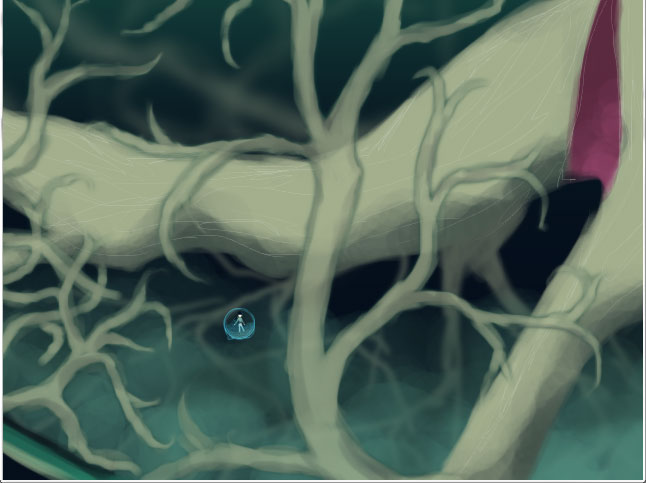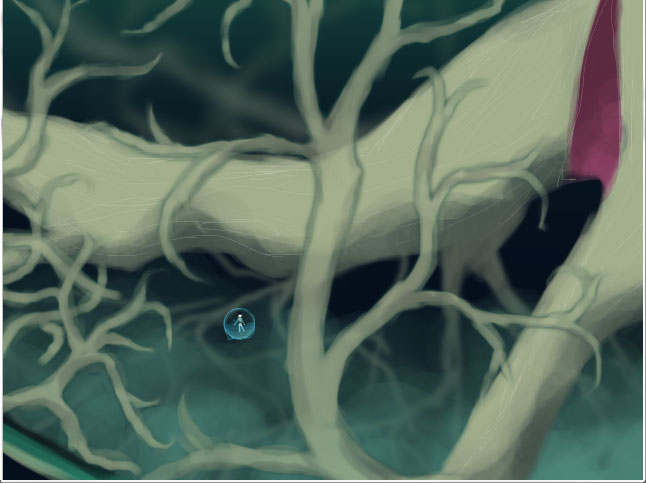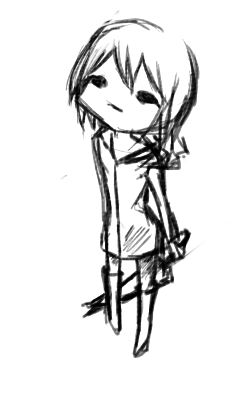I uploaded all the text in the game here.
Author: Jennifer Lee
Assignment 4 – The Ruined Society
You have been sent to a deserted world to figure out what caused it’s collapse. Press x to interact with objects and move with the arrow keys. (Annoyingly, you have to use the mouse to click on message box options, I couldn’t figure out how to fix that.) Download and play here if you’re on windows. (Game maker 8.1 can only make export as .exe.)
(To save you the trouble, getting 100% on the test does nothing, so don’t bother. Also, there is no ending, so if you think you’ve explored everything, you’re probably done. Ideally, this game would have more places to explore, less rushed backgrounds, and an introduction to establish the universe a bit.)
Assignment 4 – Readings
Game Design as Narrative Architecture
This paper did a good job of outlining a lot of the general debate regarding player choice and tight narrative. As more and more games of this generation get criticized for not having enough “choice” (Mass Effect 3’s ending comes to mind), more large franchises seem to be deciding that all games definitely need choice. Personally, I believe that having focusing too much on choice either waters down the story or eventually makes the choices irrelevant (regardless of what you choose, you get the same result anyway.)
The idea of game designers being more narrative architects is interesting, and distinctly made me think of the game Yume Nikki, a free game that has no real narrative, just a beginning and an end and a (majorly messed up) dream world to explore. The lack of narrative allows the player to think of their own back story to go with the environments and the small hints in the world. I found this a more memorable experience than most “epic” stories in other games.
Narrative Environments from Disneyland to World of Warcraft
I read this article hoping to see more about the narrative architect idea in the other article, but instead got a discussion about environments and community in MMORPGS. While I can definitely see communities forming from MMORPGS, (WoW guilds and such), I don’t feel the environments partake as much of a narrative in games like WoW. While there is a main story, the environment quickly becomes a series of points based on what is available at each point (sell items here, pick up quest here, etc.)
Assignment 4 – Demo
A mainly exploring game. I haven’t actually figured out gameplay yet, but most likely you will just move around and interact with the environment. You play as a girl who has been sent on a mission to explore a nearby world and see if it is inhabitable. Every world has a single world tree that all the inhabitants live within and get all resources from.
Assignment 3 – Tree of Happiness
Play here. This is sadly more of a prototype than a finished product, but I intended to have more objects to interact with and ways to combine objects to get different endings. Also missing is a lot of the dialogue explaining why it’s called a tree of happiness, but it had to be cut due to lack of time. Sorry :\ (Also flash obnoxiously would not let me import my background music, so you get some awkward silence instead….)
Assignment 2 – The Me of Yesterday
Assignment 3 Proposal
You play as a tree of life that bears fruits of goodness. A girl comes up to you to ask for your fruit, but you cannot bear fruit without her help. All she has is a fishing rod and she cannot enter the water, but everything you need is underwater. You can help her catch things to assist you in bearing fruit by using your roots, or you can just get her to leave. Your actions will direct the conversation between the tree and the girl.
Assignment 2 Proposals
The Me of Yesterday
In your dreams (an eternal white staircase leading infinitely up), you interact with the you of yesterday. You don’t know what happens outside of the dreams, but depending on how your day went, yesterday’s version of you will be in different moods and environments. Interacting with yesterday’s you shapes how your next day will go. At the end of each dream, you also have the option of killing yesterday’s you to simply forget yesterday.
Balloon Seller
While at a festival, you meet a balloon seller who sells balloons filled with memories. They come in different colors and shapes such as bittersweet, nostalgic, that-thing-I-really-should-remember, etc. with prices that change relative to importance. Spending time with him as he sells memories to other festival-goers lets you see why he chose his profession and how other’s react to remembering what they’ve forgotten.
Readings 2
The Eliza Effect
Very interesting, especially the study with the randomized counselors and the students. The fact that Eliza only answers with questions or just repetitions of what the user enters had me wondering if it was possible for Eliza to give responses that would expand the conversation or give advice. This lead me to think about smarterchild and other such chatbots and how they learn from each conversation to get better and better at emulating a human. I wonder if this can be placed into games without completely breaking gameplay? Something like a game A.I. that would slowly learn your play style and thus get more difficult as you got more used to the game. (I think flower did something like this but I’m not entirely sure.)
Hills like White Elephants
The avoidance of the actual subject of abortion was incredibly interesting and engaging to read. It directly reminded me of The Garden of Forking Paths where the character had stated the way to bring attention to the word time is to omit it.
Assignment 1: Can You Save Ted?
Ted is Future Corporations prototype sentient android. He just got hacked. Can you save Ted?







